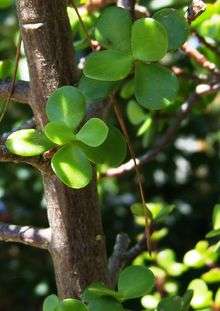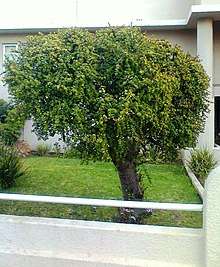Portulacaria
Portulacaria is a genus of succulent plant, classified in its own subfamily Portulacarioideae in the family Didiereaceae. It is indigenous to southern Africa.
| Portulacaria | |
|---|---|
 | |
| Portulacaria afra | |
 | |
| Mature Portulacaria afra | |
| Scientific classification | |
| Kingdom: | Plantae |
| Clade: | Tracheophytes |
| Clade: | Angiosperms |
| Clade: | Eudicots |
| Order: | Caryophyllales |
| Family: | Didiereaceae |
| Subfamily: | Portulacarioideae |
| Genus: | Portulacaria Jacq. |
Taxonomy
The genus was previously placed in the family Portulacaceae, but according to molecular studies is part of Didiereaceae.
It has further been revised when phylogenetic tests showed conclusively that genus Ceraria was located within Portulacaria, and all Ceraria species have consequently been renamed and moved into this genus.[1]
Species

Species include:
- Portulacaria afra Jacq.
- Portulacaria armiana E. J. Van Jaarsveld
- Portulacaria carrissoana. Previously Ceraria carrissoana Excell & Mendonca
- Portulacaria fruticulosa. Previously Ceraria fruticulosa Pearson & Stephens
- Portulacaria longipedunculata. Previously Ceraria longipedunculata Merxm & Podlech
- Portulacaria namaquensis. Previously Ceraria namaquensis Sond.
- Portulacaria pygmaea. Previously Ceraria pygmaea Pillans
Uses
Portulacaria afra normally uses C3 (or Hatch-Slack) carbon fixation but is also able to switch to CAM carbon fixation when drought stressed.
It is a local delicacy and its leaves are eaten by the local peoples. It is also popular internationally as a garden plant.[2] Because of its superficial resemblance to some species in the family Crassulaceae, most of which are toxic,[3] the two are readily, and possibly dangerously, confused by people unaware of the differences.
References
- P.Bruyns, M.Oliveira-Neto, G.F. Melo de Pinna, C.Klak: Phylogenetic relationships in the Didiereaceae with special reference to subfamily Portulacarioideae. Taxon 63 (5). October 2014. 1053-1064.
- Guralnick, L. J.; Ting, I. P. (1987). "Physiological Changes in Portulacaria afra (L.) Jacq. during a Summer Drought and Rewatering". Plant Physiology. 85 (2): 481–6. doi:10.1104/pp.85.2.481. PMC 1054282. PMID 16665724.
- Watt, John Mitchell; Breyer-Brandwijk, Maria Gerdina: The Medicinal and Poisonous Plants of Southern and Eastern Africa 2nd ed Pub. E & S Livingstone 1962
External links
| Wikimedia Commons has media related to Portulacaria. |